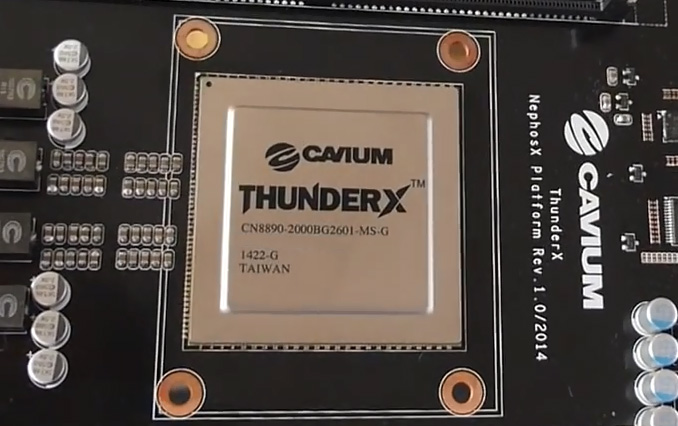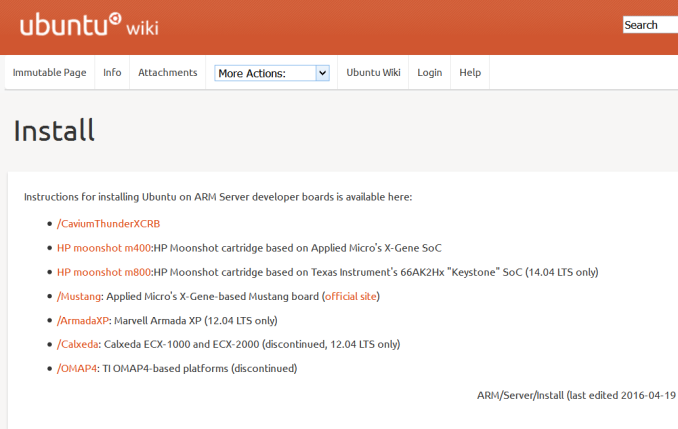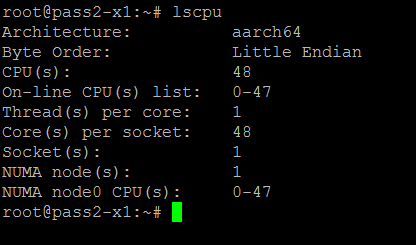Investigating Cavium's ThunderX: The First ARM Server SoC With Ambition
by Johan De Gelas on June 15, 2016 8:00 AM EST- Posted in
- SoCs
- IT Computing
- Enterprise
- Enterprise CPUs
- Microserver
- Cavium

When is a worthy alternative to Intel's Xeon finally going to appear? That is the burning question in the server world. If PowerPoint presentations from various ARM-based SoCs designers released earlier this decade were to be believed, Intel would now be fighting desperately to keep a foothold in the low end server market. But the ARM SoCs so far have always disappointed: the Opteron A1100 was too late, the X-Gene 1 performed poorly, consumed too much power, and Broadcomm's Vulcan project is most likely dead. This Ubuntu page is an excellent illustration of the current state of the ARM server market:
Discontinued products, many announced products which do not even appear on this page (we are in the middle of 2016, after all), and despite the fact that there is an ARM Server Base System Architecture (SBSA) specification, every vendor has its own installation procedure. It is still a somewhat chaotic scene.
Meanwhile, Intel listened to their "hyperscaler customers" (Facebook, Google...) and delivered the Xeon D. We reviewed Intel's Broadwell SoC and we had to conclude that this was one of the best products that Intel made in years. It is set a new performance per watt standard and integrated a lot of I/O. The market agreed: Facebook's new web farms were built upon this new platform, ARM servers SoCs were only successful in the (low end) storage server world. To make matter worse, Intel expanded the Xeon D line with even higher performing 12 and 16 core models.
But losing a battle does not mean you lose the war. Finally, we have a working and available ARM server SoC which has more ambition than beating the old Atom C2000 SoC. In fact, Cavium's ThunderX SoC has been shipping since last year, but you need more than silicon to get a fully working server. Firmware and kernel need to get along, and most libraries need to be compiled with platform-specific optimizations. So the quality assurance teams had a lot of work to do before Cavium could ship a server that could actually run some server software in a production environment. But that work has finally been finished. Cavium send us the Gigabyte R120-T30 running Ubuntu 14.04 server with a ThunderX ready Linux kernel (4.2.0) and ThunderX optimized tools (gcc 5.2.0 etc.).
Cavium?
Who is Cavium anyway? Even for those working in the enterprise IT, it is not a well known semiconductor company. Still, Cavium has proven itself as fabless network/security/storage and video SoC designing company. The company based in San José counts IBM, Juniper, Qualcomm, Netgear, Cisco among its customers.
With a net revenue of about $400 million, Cavium is about one-tenth the size of AMD. But then again, Cavium either reports small losses or smal profits despite heavy investments in the new ARMv8 project ThunderX. In other words, the company's financials look healthy. And Cavium did already design a 16-core MIPS64 Octeon Network Service Processor (NSP) back in 2006. So Cavium does have a lot of experience with high core count SoCs: the network processor Octeon III CN78xx has 48 of them.
Handling server applications is of course very different from network processing. A large amount of independent network packets creates a lot of parallelism, and more complex computation can be offloaded to co-processors. Still, Cavium is the first vendor that delivers an ARMv8 server chip with an impressive core count: no less than 48 cores can be found inside the ThunderX die.
To keep the design effort reasonable, Cavium based their first ARMv8 server processor, ThunderX, on the Octeon III CN78xx. We described this in more detail here, but the main trade-off is that Cavium used a relatively simple dual issue core. As a result, single threaded performance is expected to be relatively low. On the opposite side of the coin however, it is the first ARM SoC that has claimed throughput numbers in the realm of the best Xeon D and even midrange Xeon E5, instead of competing with the Atom C2000. It is the most ambitious ARMv8 SoC that has made it into production.
All of this gives us plenty of reasons to put the Cavium ThunderX through paces. And throwing in the latest Supermicro boards with the latest 12 and 16 core Xeon-Ds made it a lot more interesting ...












82 Comments
View All Comments
Spunjji - Wednesday, June 15, 2016 - link
Well, this is certainly promising. Absent AMD, Intel need some healthy competition in this market - even if it is in something of a niche area.niva - Wednesday, June 15, 2016 - link
This is the area where profits are made, not "something of a niche area."Shadow7037932 - Wednesday, June 15, 2016 - link
Yeah, I mean getting some big customers like Facebook or Google would be rather profitable I'd imagine.JohanAnandtech - Thursday, June 16, 2016 - link
More than 30% of Intel's revenue, and the most profitable area for years, and for years to come...prisonerX - Wednesday, June 15, 2016 - link
This is the future. Single thread performance has reached a dead end and parallelism is the only way forward. Intel's legacy architecture is a millstone around its neck. ARM's open model and efficient implementation will deliver more cores and more performance as software adapts.The monopolists monopolise themselves into irrelevance yet again.
CajunArson - Wednesday, June 15, 2016 - link
" Intel's legacy architecture is a millstone around its neck."I wouldn't call those Xeon-D parts putting up excellent performance at lower prices and vastly lower power consumption levels to be any kind of "millstone".
"ARM's open model and efficient implementation "
What's "open" about these Cavium chips exactly? They can only run a few specialized Linux flavors that don't even have the full range of standard PC software available to them.
What is efficient about a brand-new ARM chip from 2016 losing at performance per watt to the 4.5 year old Sandy Bridge parts that you were insulting?
As for monopolies, ARM has monopolized the mobile market and brought us "open" ecosystems like the iPhone walled-garden and Android devices that literally never receive security updates. I'd take a plain x86 PC that I can slap Linux on any day of the week over the true monopoly that ARM has over locked-down smartphones.
shelbystripes - Wednesday, June 15, 2016 - link
You're right to criticize the "millstone" comment, Intel has done quite well achieving both high performance and high performance-per-watt in their server designs.But your comment about a "true monopoly" in the "locked-down smartphone" market is ridiculous. The openness (or lack thereof) that you're complaining about has nothing to do with the CPU architecture at all. An x86 smartphone or tablet can just as easily be locked down, and they are. I own a Dell Venue 8 7000, which is an Android tablet with an Intel Atom SoC inside. It's a great tablet with great hardware. But it's got a bunch of uninstallable crapware installed, Dell abandoned it after 5.1 (it's ridiculous that a tablet with a quad-core 2GHz SoC and 2GB RAM will never see Marshmallow), and the locked smartphone-esque bootloader means I can't repurpose it to a Linux distro even if one existed that supported all the hardware inside this thing.
On the flipside, the most popular open-source learning/development solution out there right now is the ARM-based Raspberry Pi. There are a number of Linux distros available for it, and everything is OSS, even the GPU driver.
TheLightbringer - Thursday, June 16, 2016 - link
You haven't done your homework.Some mobile devices were coming with Intel. But like Microsoft it entered the market too late, without offering any real value. The phrase "Too little, too late" fit them both.
ARM didn't do a monopoly. They just simply saw an opportunity and embrace it. In the early IBM clone days Intel licensed their architecture to allow competition and broad arrange of products. After the market was won, they went greedy, didn't licensed the architecture anymore and cut a lot of players out, leaving a need for a chip licensing scheme. And that's where ARM got in.
Google develops Android OS, but is up to phone vendors and carriers to deploy them. And they don't want to for economic reasons. They prefer to sell you a new phone for $$$.
Intel and MS got in the mobile/car market exactly what they deserve, nothing else.
junky77 - Friday, June 17, 2016 - link
they all greedy. Some just play it smartly or have more luck in decision makingBut, yea, when you read about the way IBM behaved when things were fresh - it's quite amazing. They had much of the market and could do a lot of stuff, but they simply had a very narrow mind set
soaringrocks - Wednesday, June 15, 2016 - link
You make it sound like it's mostly a SW problem, I think it's more complex than that. Actual performance is very dependent on the types of workload and some tasks fit Intel CPUs nicely and the performance per watt for ARM is lacking despite the hype of that architecture being uniquely qualified for low-power. It will be fun to watch how the battle evolves though.